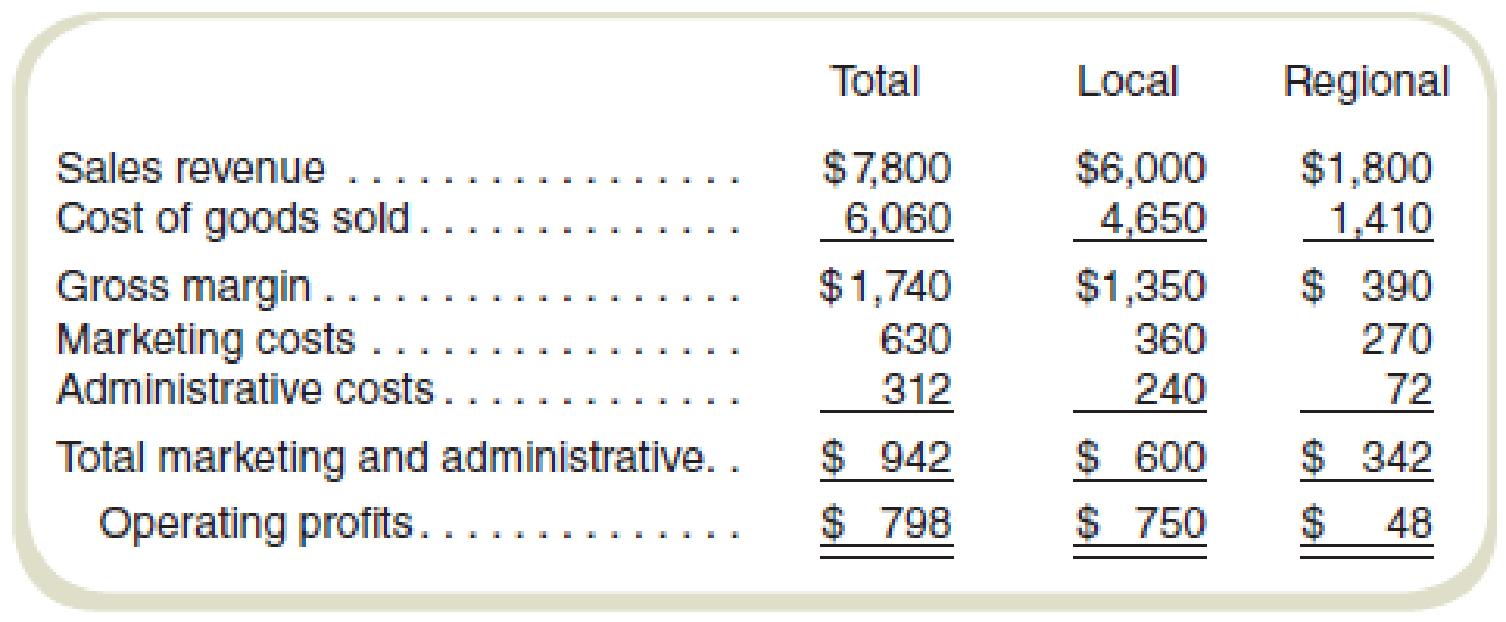
Agnew Manufacturing produces and sells three models of a single product, Standard, Superior, and DeLuxe, in a local market and in a regional market. At the end of the first quarter of the current year, the following income statement (in thousands of dollars) has been prepared:

Management has expressed special concern with the regional market because of the extremely poor return on sales. This market was entered a year ago because of excess capacity. It was originally believed that the return on sales would improve with time, but after a year, no noticeable improvement can be seen from the results as reported in the preceding quarterly statement.
In attempting to decide whether to eliminate the regional market, the following information has been gathered:


All administrative costs and fixed
Required
- a. Assuming there are no alternative uses for Agnew’s present capacity, would you recommend dropping the regional market? Why or why not?
- b. Prepare the quarterly income statement showing contribution margins by products. Do not allocate fixed costs to products.
- c. It is believed that a new model can be ready for sale next year if Agnew decides to go ahead with continued research. The new product would replace DeLuxe and can be produced by simply converting equipment presently used in producing the DeLuxe model. This conversion will increase fixed costs by $60,000 per quarter. What must be the minimum contribution margin per quarter for the new model to make the changeover financially feasible?
Want to see the full answer?
Check out a sample textbook solution
Chapter 4 Solutions
Gen Combo Fundamentals Of Cost Accounting; Connect Access Card
- Please given answer general accountingarrow_forwardCrowd Company applies overhead based on direct labor cost. Estimated overhead and direct labor costs for the year were $123,500 and $138,000, respectively. During the year, actual overhead was $114,400, and actual direct labor cost was $133,000. The entry to close the over- or underapplied overhead at year-end, assuming an immaterial amount, would include: Answerarrow_forwardX Company has two production departments, 1 and 2. Listed below are budgeted information for the two departments, and actual information for one of its products, Product X: Department 1 All Products Product X Overhead $4,320,000 Direct labor $600,000 $10,800 Direct labor hours 55,000 925 Machine hours 100,000 1,020 Units produced 56,000 650 Department 2 Overhead $2,530,000 - Direct labor $600,000 $3,840 Direct labor hours 55,000 345 Machine hours 133,000 850 Units produced 32,000 650 Using a plant-wide allocation system with direct labor hours as the cost driver, what was the allocation to Product X?arrow_forward
- Crich Corporation uses direct labor hours in its predetermined overhead rate. At the beginning of the year, the estimated direct labor hours were 33,280 hours and the total estimated manufacturing overhead was $634,368. At the end of the year, actual direct labor hours for the year were 31,500 hours and the actual manufacturing overhead for the year was $634,368. Overhead at the end of the year was _.arrow_forwardCrowd Company applies overhead based on direct labor cost. Estimated overhead and direct labor costs for the year were $123,500 and $138,000, respectively. During the year, actual overhead was $114,400, and actual direct labor cost was $133,000. The entry to close the over- or underapplied overhead at year-end, assuming an immaterial amount, would include: Don't Use Aiarrow_forwardWhat is the firm's ROA ?arrow_forward
 Cornerstones of Cost Management (Cornerstones Ser...AccountingISBN:9781305970663Author:Don R. Hansen, Maryanne M. MowenPublisher:Cengage Learning
Cornerstones of Cost Management (Cornerstones Ser...AccountingISBN:9781305970663Author:Don R. Hansen, Maryanne M. MowenPublisher:Cengage Learning Managerial Accounting: The Cornerstone of Busines...AccountingISBN:9781337115773Author:Maryanne M. Mowen, Don R. Hansen, Dan L. HeitgerPublisher:Cengage Learning
Managerial Accounting: The Cornerstone of Busines...AccountingISBN:9781337115773Author:Maryanne M. Mowen, Don R. Hansen, Dan L. HeitgerPublisher:Cengage Learning

